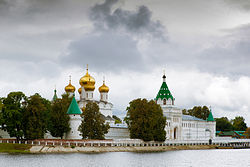Ipatievsky Monastery

The monastery as seen from across the Kostroma River
|
|
| Monastery information | |
|---|---|
| Order | Orthodox |
| Established | 1330 (or 1275) |
| Disestablished | 1918 |
| Diocese | Kostroma |
| People | |
| Founder(s) | Zacharias, nobleman of Kostroma |
| Site | |
| Location | Kostroma, Russia |
| Coordinates | 57°46′35″N 40°53′40″E / 57.77639°N 40.89444°ECoordinates: 57°46′35″N 40°53′40″E / 57.77639°N 40.89444°E |
The Ipatiev Monastery (Ипатьевский монастырь in Russian)—sometimes translated into English as Hypatian Monastery—is a male monastery, situated on the bank of the Kostroma River just opposite the city of Kostroma. It was founded around 1330 by a Tatar convert, Prince Chet, whose male-line descendants include Solomonia Saburova and Boris Godunov and dedicated to St. Hypatios of Gangara.
In 1435, Vasily II concluded a peace with his cousin Vasily Kosoy there. At that time, the cloister was a notable centre of learning. It was here that Nikolay Karamzin discovered a set of three 14th-century chronicles, including the Primary Chronicle, now known as the Hypatian Codex.
During the Time of Troubles in Russia, the Ipatiev Monastery was occupied by the supporters of False Dmitriy II in the spring of 1609. In September of that same year, the monastery was captured by the Muscovite army after a long siege. On March 14, 1613, the Zemsky Sobor announced that Mikhail Romanov, who was in this monastery at the time, would be the Russian tsar.
Most of the monastery buildings date from the 16th and 17th centuries. The Trinity Cathedral is famous for its elaborately painted interior. A smaller church was demolished by the Soviet authorities. There are plans to reconstruct it and consecrate it to the New Martyrs of the Romanov family. The main entrance from the riverside was designed by the celebrated Konstantin Thon. A private house of Mikhail Romanov was restored on the orders of Alexander II of Russia, but even Konstantin Pobedonostsev questioned the authenticity of this reconstruction.
...
Wikipedia
